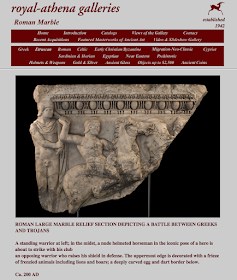On January 8, 2017 forensic archaeologist Christos Tsirogiannis alerted Assistant District Attorney Matthew Bogdanos in Manhattan and ARCA that he had identified another illicit antiquity, apparently being laundered via the US art market. The object in question had been listed for sale via Royal-Athena Galleries, a New York City-based gallery which is operated by Jerome Eisenberg.
 |
| Screen Capture - Royal-Athena Galleries 1 |
According to Tsirogiannis the object identified was a 64.8 x 90.8 cm. sarcophagus fragment which matches four polaroid images and three handwritten notes found in the Becchina archive.
This accumulation of records was seized by Swiss and Italian authorities in 2002 during raids conducted on Gianfranco Becchina’s gallery, Palladion Antique Kunst, as well as two storage facilities inside the Basel Freeport, and another elsewhere in Switzerland. The Becchina Archive consists of some 140 binders which contain more than 13,000 documents related to the antiquities dealer's business.
These records include shipping manifests, dealer notes, invoices, pricing documents, and thousands of photographic images. Many of the images are not slick art gallery salesroom photos, but rather, are point and shoot polaroids taken by looters and middlemen which depict recently looted antiquities, some of which still bear soil and salt encrustations.
In 2011 Becchina was convicted in Italy for his role in the illegal antiquities trade and while he later appealed this conviction, looted antiquities traced to his trafficking network, like this sarcophagus fragment, continue to surface in private collections, museums and some of the world's most well know auction firms specializing in ancient art.
In releasing his identifications to ARCA Tsirogiannis said:
"Regarding the sarcophagus fragment, each of the four Polaroid images depicting the fragment is included in a different file of the Becchina archive:
I discovered the first image (attachment no. 1) in a file that Becchina created to archive the antiquities he was receiving from a Greek trafficker termed in the archive ‘ZE’ or ‘ZENE’ (the beginning of his surname) or ‘Giorgio’ (Giorgos, his first name in Greek). This trafficker, now deceased, was well-known to the Greek police art squad.
 |
| attachment no. 1 |
In a separate handwritten note (attachment no. 2), Becchina records that he received the antiquity (‘1 Frto. [meaning ‘Fragment’] di sarcofago’) for 60.000 Swiss Francs on 25 May 1988.
 |
| attachment no. 2 |
This antiquity is recorded as the 9th object included in the 34th group of antiquities that ‘Zene’ sent to Becchina (see attachment no. 3).
 |
| attachment no. 3 |
Another note (attachment no. 4), a handwritten page, lists a group of antiquities that Becchina bought from ‘Zene’, from November 1986 until October 1988, for more than $250,000, including the sarcophagus’ fragment (no. 9).
 |
| attachment no. 4 |
The fifth attachment is a photocopy of a Polaroid image, depicting the same antiquity; this image was attached to a blank A4 page, together with other Polaroid images depicting other antiquities that ‘Zene’ smuggled from Greece to Becchina, under the title ‘in PF’, meaning that all these antiquities were stored at the time at the P[ort] [F]ranc (the Free Port) of Basel.
 |
| attachment no. 5 |
In Becchina’s list of antiquities stored in his warehouses in the Free Port of Basel, the sarcophagus fragment was number 21 (see sixth attachment, another Polaroid image).
 |
| attachment no. 6 |
Finally, I am sending you another handwritten note (attachment no. 7), in which Becchina is asking one of the restorers he was using, Andre Lorenceau, to clean (‘reinigen’) the fragment and to add a base (‘sockeln’), as a support (by drilling into the antiquity). I discovered this note in the Becchina file dedicated to his cooperation with the restorer Andre Lorenceau."
 |
| attachment no. 7 |
According to the Royal-Athena Galleries website, the sarcophagus fragment has been attributed by Dr. Guntram Koch, an academic with an expertise in Roman sarcophagoi.
 |
| Screen Capture - Royal-Athena Galleries 2 |
In addition to notifying the New York authorities, Tsirogiannis informed INTERPOL and the Greek police art squad.
The object in question was seized by US authorities at approximately January 14 2:00 pm EST.
Nearly ten years ago in November 2007 Eisenberg returned eight antiquities stolen from museums and archaeological sites worth US$ 510,000 to Italy. Given the fact that it often takes sound identifications, such as those conducted by researchers such as Tsirogiannis, restitutions by art market dealers should not be misconstrued as spontaneous. In most cases pieces are relinquished merely to avoid lengthy litigation or in order for suspect dealers to remove themselves from the negative publicity caused by being subject to criminal charges.
Nearly ten years ago in November 2007 Eisenberg returned eight antiquities stolen from museums and archaeological sites worth US$ 510,000 to Italy. Given the fact that it often takes sound identifications, such as those conducted by researchers such as Tsirogiannis, restitutions by art market dealers should not be misconstrued as spontaneous. In most cases pieces are relinquished merely to avoid lengthy litigation or in order for suspect dealers to remove themselves from the negative publicity caused by being subject to criminal charges.
By: Lynda Albertson

No comments:
Post a Comment